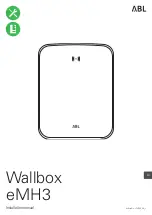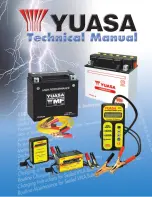
REV D
Page
12
Digital Display
•
During the charging process,
the display shows ‘CH1’ charging voltage, current, and status
repeatedly, and ‘CH2’ or ‘CH3’ is solid to indicate the recent active input source. If the other input
channel
(‘CH3’ or ‘CH2’ respectively) is available and its voltage is above its corresponding ‘Start-
Up” voltage threshold, the icon will be flashing.
•
When
‘INFO’ button is pressed once during the charging process, the display will change to
show CH2 voltage for 3 seconds and CH3 voltage for 3 seconds. The display will then go back to
normal mode automatically, and show the CH1 information again.
•
When the House Battery Bank (CH1) is fully charged, the display shows
‘CH1’ together with a
cyclic sequence of its voltage, current, and the icon
‘FLO’ (for Float) repeatedly on the display.
•
The selected
‘battery type’ icon remains on most of the time when the display is ON (i.e. during
the charging process, setting menu, etc.)
•
The
‘Priority’ icon turns ON when the ‘Control’ terminal is connected to high or the unit is set to
‘Manual Override’ mode. For more details, read the following table.
Button Functions
•
During normal charging operation, press once to change the display to show CH2 and CH3 voltage and press once
more to go back to normal display.
•
Anytime the display is on* by whatever reason (except during the setting menu), press and hold for more than 3 sec.
to enter the unit Setup Mode. To leave the menu, do the same or wait for about 10-15 sec pushing no button at all.
•
When both CH2 and CH3 are not available (i.e. below their corresponding Start-Up voltage thresholds), the display
will go OFF to save house battery. Pressing and holding this button for more than 3 seconds, will temporary trigger
the display showing the sequence of all the three channels voltages, all the icons, the software revision numbers, and
finally the CH1 voltage and current alternately for a few seconds, before finally going off.
•
During the charger Setup Mode, this button is used to confirm (save) the setting, and continue to the next one.
Note: The selected setting will quickly flash 3 times to acknowledge the setting.
•
Manual Override Mode: Anytime the display is on* by whatever reason (except during the setting menu) press and
hold this button for more than 10 seconds to enable this mode. The "Priority" icon will be displayed. In this mode, the
voltage thresholds to start and use of CH3 as the charging source, are reduced so to enforce its use even more. Use
the same procedure to turn off the ‘Manual Override Mode’ when it is not required. This mode is disabled after either
turning the unit off or disconnecting the house battery.
•
Please note: If
‘Manual Override Mode’ is used and left on, there is a risk of flattening the start (vehicle) battery
(CH3). The preferred method is to use the automatic override mode by connecting the ignition
“+” signal (or even
better a
“+” one indicating engine running) to the “Control” terminal of the charger, so to make sure that the Override
Mode is activated only when the engine alternator is running. This automatic setting is useful for vehicles equipped
with Smart Regenerative Alternators (SRCS) which supply maximum voltages as low as 12.4V
•
Equalization Mode: With
“Flooded” battery type setting, anytime the display is on* by whatever reason (except during
the setting menu), press and hold
the “NEXT“ and “SET“ buttons together for more than 5 sec. to enable the
equalization mode in the CH1
(House Battery).The display will temporarily show “Eq” and the ”Flooded” icon.
•
Please note: the battery has to be set to
“Flooded” type in order to have this function enabled.
•
During the charger Setup Mode, this button is used to change to the next setting of a specific parameter.
•
‘Silent’ (Fan OFF) mode: Anytime that the display is on* by whatever reason (except during the setting menu), press
and hold this button for more than 3 seconds to force the fan to turn OFF.
The “Auto” icon will turn ON. The charger
current will reduce to about half the set current. Use the same procedure to disable the
‘Silent Mode’ and turning the
“Auto” icon Off. This functionality will be done automatically after 12 hours.
Note * If the display is off (i.e. when in battery-save condition with both CH2 and CH3 not available) you can turn it on by using the
“INFO” button as explained above, and waiting for the complete sequence until showing the CH1 voltage and current. Then, push
and hold the corresponding button or buttons to enable the desired
operating mode (“Setup”, “Manual Override”, “Equalization”, or
“Silent”)
General Note:
Every time the “INFO“, “NEXT“ and/or “SET“ buttons are pressed, the back light will illuminate and automatically
turn off after 60 seconds. When the display is in a temporary showing condition (i.e. during the setting menu, or after the
“INFO”
button sequence explained above), it will enter the power-save mode and go off if no push button is pressed for approximately10-
15 sec.
Automatic Override Functions
When a positive signal
is applied to the “Control”, the Override (Priority) mode is enabled, allowing
the connection to the CH3 (vehicle battery) at a lower Start-Up voltage threshold >12.3V/24.6V
(from the normal >13.2V/26.4V) on a 12V/24V nominal start battery input respectively.
Custom Setting Your Charger
Use the “INFO”, “SET”, and “NEXT’ pushbuttons to enter the setup mode and its setting menu,
select the setting of a specific parameter, and save & advance to the next parameter, respectively.
Refer to the detailed explanation in the table above.
Understanding the Three-Stage (Mode 3), Two-Stage (Mode 2) Charging
The Three-Stage Charging (Mode 3) consists of Bulk, Absorption and then Float stages. During the
Bulk stage, the house battery (on CH 1) accepts the maximum constant current from the charger
as per the setting. In the Absorption stage, the battery voltage is held to constant voltage and the
charging current will slowly reduce. In Float stage, the charger continuously produces lower
Содержание DMT1230
Страница 1: ...Abso DC to DC Battery Charger 12V 30A DMT1230 12V 50A DMT1250 24V 30A DMT2430 Owner s Manual...
Страница 18: ...REV D Page 18...
Страница 19: ...REV D Page 19...
Страница 20: ...REV D Page 20...
Страница 21: ...REV D Page 21...
Страница 22: ...REV D Page 22...
Страница 23: ...REV D Page 23...
Страница 24: ...REV D Page 24 Printed in China...










































